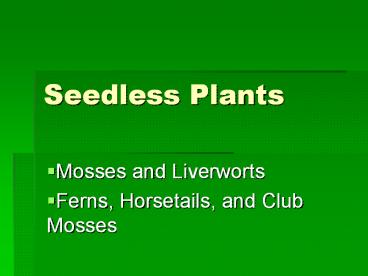Seedless Plants - PowerPoint PPT Presentation
Title:
Seedless Plants
Description:
Covering soil or rocks in a mat of tiny green plants ... Usually the first plants to inhabit a new environment. Form a thin layer of soil when they die. ... – PowerPoint PPT presentation
Number of Views:21
Avg rating:3.0/5.0
Title: Seedless Plants
1
Seedless Plants
- Mosses and Liverworts
- Ferns, Horsetails, and Club Mosses
2
Mosses and Liverworts
- Small
- Live on bark, rocks, and soil
- No vascular system
- Must live in places that are wet
- No true roots, stems, or leaves
3
Mosses
4
Liverworts
5
Mosses and Liverworts
- Live together in large groups
- Covering soil or rocks in a mat of tiny green
plants - Each moss has rhizoids (root-like structures)
- Rhizoids help anchor the plant
6
Importance of Mosses and Liverworts
- Usually the first plants to inhabit a new
environment. - Form a thin layer of soil when they die.
- They help hold the soil in place which prevents
erosion. - Nesting material for birds.
- Peat moss can be burned as fuel.
7
Ferns, Horsetails, and Club Mosses
- Grow tall
- Have vascular systems
8
Ferns
9
Ferns
- Can grow almost anywhere.
- Have an underground stem called a rhizome.
- Leaves are called fronds.
10
Horsetails
11
Horsetails
- Small vascular plants.
- Grow less than 1.3 meters tall.
- Grow in wet, marshy places.
- Stems are hollow and contain cilia.
- Pioneers used them to scrub pots and pans.
12
Club Mosses
- 25 cm tall.
- Grow in woodlands.
- Unlike other mosses, they have vascular tissue.
13
Importance of Seedless Vascular Plants
- Help form soil when they die.
- Also hold soil in place to prevent erosion.
- Ferns serve as house plants.
- Some are cooked and eaten.
- Formed coal.































